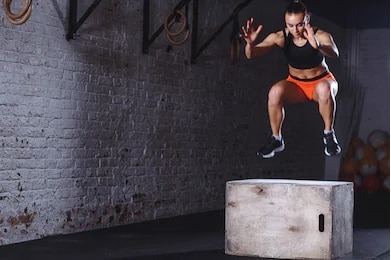
The Average Vertical Jump for men and women can be established by testing for a Standing Vertical Jump and/or for a Running Vertical Jump.
Standard Vertical Jump Testing has been conducted to establish how men compare to women, when they are mere amateurs and when they are at the peak of their powers.
This blog features tables and sources that help you make meaningful jump comparisons for both males and females, when they are poor jumpers, when they are average jumpers, when they are good jumpers and when they are outstanding jumpers.
Generally you Test Your Vertical to establish how good you are before you start jumping competitively. You do that so you can then monitor how good your jump is through the various stages of your athletic development.
In this blog we also have a table and sources which illustrate how male and female jumpers develop from a young age until they are competitive athletes. The table helps create jump comparisons between males and females at various stages of their physical development - from childhood to adulthood.
Finally, in this blog we also make comparisons for those competing in the various sporting codes, where jumping is important. That includes basketball, volleyball and American football. That data has been retrieved from formal governing bodies for those sports.
Average Jump Heights For Both Males And Females
Before we crunch any kind of numbers here, we are going to state some of the obvious, to help explain why things are the way they are.
At most levels, male athletes are likely to outperform their female counterparts. That regardless of whether you are measuring a poor, average, good or excellent jump.
Most of that has to do with the capacity of both genders to store and use the elastic energy in the extensor muscles of the lower limbs. The point of contention being the gender that uses the energy more efficiently throughout the jumping motion.
Throughout these pages, we wax lyrical about all the muscles that contribute to a higher jump but ultimately that is all really determined by the explosive power produced in the lower body and the amount of energy used to try and produce that explosive power.
One study, focusing on a sample of physical education students, revealed that the average female performance was about 50 percent lower than that of the males who took part in the three experiments. Those sets of experiments saw both the men and women jumping from a squat position, with a countermovement and finally from a drop.
Of particular interest to us, though, is not so much the maximum heights recorded during these experiments but rather it is the efficiency with which the energy was used during the jumping movement and this is ultimately where the differences were most telling.
While it has been established that women are actually much better at using all of the energy they have at their disposal during the jumping process (this might have a little to do with female body dynamics), men have the capacity to store and sustain much higher loads of energy during the stretching phase of the jump process.
What was also established in the study we mentioned above was that having progressed from a squatting jump to a countermovement jump, it was in fact the women that made more progress than their male counterparts - 21% vs 13% to be a little more precise.
The women also recorded better progressions from the squatting jump to the drop jump.
Also worth noting, though, is that men start storing even more energy the higher the drop is for the latter. All of that makes little difference to the final outcomes though. Men just jump higher.
Those same sources also reveal that the Average Vertical Jump For Men is anything between 16-20 inches.
Naturally, there will always be exceptions that make the rule. There will always be boys and girls with remarkable genes that have the capacity to match and even outperform adults.
Likewise there are grown men and women who will just never have what it takes to jump considerably higher - it often takes a lot of time for either of them to realise that too.
Average Vertical leap - Where Do You Rank?
Rank | Men (Cm) | Women (Cm) |
|---|---|---|
Piss poor | Less than 21 | less than 11 |
poor | 21-30 | 11-20 |
Mediocre | 31-40 | 21-30 |
average | 41-50 | 31-40 |
good | 51-60 | 41-50 |
very good | 61-70 | 51-60 |
excellent | more than 70 | more than 60 |
Average Jump Heights By Age For Males And Females
In keeping with this theme of progression (or regression) it is worth noting the changes that are recorded - and widely accepted - as being the average through the various phases of development.
There are multiple facets that could be examined, to varying degrees here. Chief among those, perhaps, is age. The other relevant factors are weight and height, both of which are often directly related to age but that is not always the case.
The differences recorded between boys and girls can also be quite telling. The most significant of those changes are recorded during adolescence - probably the most meaningful period of transition for males and females in general. So, that is why we are going to place emphasis on that in this blog.
When you examine our positively medieval table below - which we must stress is just a set of findings that were made in one study of volleyball players - something glaring becomes apparent straight away.
age | male | female |
|---|---|---|
13 years old | 30 | 30 |
14 years old | 31 | 32 |
15 years old | 35 | 32 |
16 years old | 37 | 30 |
17 years old | 39 | 30 |
18 years old | 40 | 31 |
19 years old | 41 | 31 |
What Is An Excellent Vertical Jump in each sport?
Basketball (NBA Draft Combine)

In basketball two vertical height measurements matter during professional drafting. The first is the Standing Jump and the second is the Max Jump. If you are recording anything higher than 30 inches for the Standing Vertical, you are doing very well. Some might even say excellent!
If you are recording anything in the region of 40 inches for the Max Vertical, you will find yourself in pretty good company there too - the cream of the crop really!
American Football (NFL Draft Combine)

In American Football the height recorded by prospective professionals, during the scouting process, is merely one consideration in a sport so dynamic. It is a consideration for coaches and administrators nevertheless.
The highest vertical recorded in the history of this scouting process is 46 inches - good enough to be a basketball player. The list of the best jumps in the history of the NFL Scouting Combine are all above the 40 inch mark, which is better than most professional athletes.
Volleyball (Unofficial)

It is distinctly more difficult to find something more reliable and official with volleyball. However, there are sources which reveal that the best vertical recorded in volleyball was somewhere in the region of 50 inches, which is most compelling.
There are even claims of 59 inches being recorded by a professional volleyball player. If anything, what we can perhaps glean from this is that recording a good height in volleyball is more telling than it would ordinarily be in other sports that require jumping.
How To Improve Your vertical
You will improve your Average Vertical Leap by training hard, resting enough in between that training and consuming a diet that promotes the production of a physically more compelling and technically more sound jump.
By performing Plyometrics, Weight and Resistance Training, you will increase the strength capacity in the muscles that are used for jumping.
Most of that training will center on the muscles in the lower body, like the glutes, hamstrings, abductors, flexors and calves.
However, a considerable amount of that training will also be directed at the upper half of the body, like the abs, the back muscles, the shoulders and the arms.
In order to perform that training and also compete consistently, you need sources of nutrients that will provide fuel for your body and help it recover once you are done training and competing. That includes water, carbohydrates and protein.
Finally, you need to recognize that winners know when to stop. Training is always good but too much practice actually weakens you and increases your exposure to injury. You cannot improve your jump if your body is not competing at optimal level.
Conclusion
How Tall To Dunk remains a relevant question, certainly in the basketball context but it is not the only question to be had - by any stretch of the imagination. As we have seen throughout this article there are more telling questions to be had on this subject.
Those are things like height, body fat, muscle mass, gender and age. Males and females have different physical advantages and disadvantages when jumping. Those need to be taken into account and should probably be a primary consideration when formulating a training regimen to jump higher.
To determine what kind of training is likely to produce better jumping outcomes and which training might just waste more time that you can ill afford to waste.
Hey, I’m Aleksandar and I am a Basketball freak! That is why I decided to create this blog. Teaching people How to dunk a basketball and How to Jump Higher in this sport or other related sports that require vertical jumping, is my specialty. If that’s your aim, then you have come to the right place.

The table below categorizes the vertical jump height in centimeters and inches for adult men and women. This ranking scale is based on my observations, and will give a general idea of what is a good score.